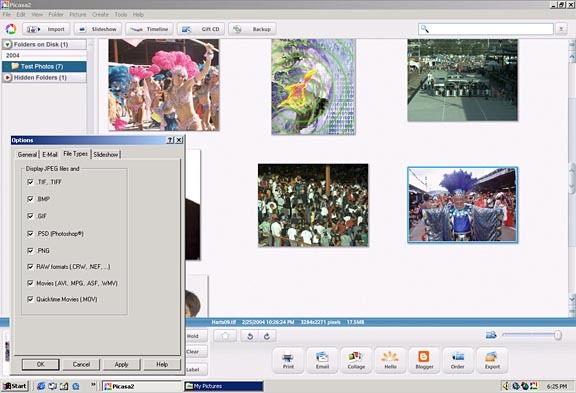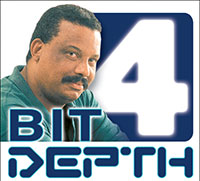BitDepth 458 - February 01
11/01/09 17:42 Filed in: BitDepth - February 2005
My approach to photography hits a watershed during Carnival 2005.
Carnival in pixels

The screen capture for this column was going to show Adobe's File Browser in action until I saw Picasa at work. Free, fast and friendly, it's the perfect partner for the photo enthusiast wading through folders full of digital photos. Image by Mark Lyndersay.
2005 may be remembered as the Carnival of the back-in-times Panorama, but it's also going to be the first Carnival that's going to be shot almost entirely by digital cameras.
For me, Carnival has always been the province of carefully edited colour transparencies, delicately mounted, labelled and preserved for the last 22 years.
I've shot Carnival seriously since 1983 and I've scanned those transparencies, logged the data supporting those images in a FileMaker Pro database and delivered them as digital files on CDs.
2004 was the year that sales of digital cameras outpaced film cameras and Kodak stopped selling film cameras. It was also the year that I was able to buy a camera capturing 8 megapixels for less than the downpayment on a house.
So I'm finally ready to say goodbye to film and capture the big show digitally.
In making that change, I'm going to have to start with the best possible source material, and that means shooting using the camera's RAW format and that means planning for handling gigabytes of data.
I've written in this space before about the problems built into the nearly ubiquitous JPEG format that most cameras use by default, and I certainly can't begin to replace the depth of data in a one-inch square of film by throwing away half the data my camera is capable of capturing.
Managing the mass of data that a day's shooting will represent, captioning it quickly when my memory is fresh and my notes can still be found and preserving both the files and information have forced me to spend all my spare time over the last few weeks thinking about a workflow that may help anyone who's planning to shoot this remarkable, expansive festival with a digital camera.
Start Here
Capturing Carnival in bits
Quality.
Shoot the highest quality image you can manage. Most cameras will give you an estimate how many JPEG pictures will fit on your card at best quality (least compression and lost data), but that's a hopeful guess. Carnival is full of tiny details and quick movements and your JPEG files will be bigger than normal because JPEG compression works best on large areas of flat colour.
Zoom.
You're too far away. If you don't have a pass for the stage or you're shooting from in the crowd at a fete at your favourite band, that little flash on your camera is useless. Find out where you can set the sensitivity of the camera to its maximum (a 400ASA equivalent is normally available)
Optical zooms are handy but avoid using the digital zoom, in fact, go through the camera's menus and turn it off. Digital zooms will butcher your image by cropping brutally into your file. It's much better to work on the best picture you can capture with an image editor.
Storage.
You don't have enough. No matter how big your card is, plan to double your capacity or have a laptop close at hand to make a dump from the card so you can reuse it. Even if you plan to shoot JPEG files, a 256MB media card will feel like a particularly stuffy closet when Harts is immediately followed by Poison.
You'll be tempted to dump pictures off your card as you shoot, but be careful. Unless the photos are clearly out of focus or badly composed, it's worth taking a second look at them on your computer's screen, the tiny LCD on a digital camera is a poor place to make serious and unrecoverable editing decisions.
Backup.
When you transfer your images back to a computer, immediately burn them to CD or DVD. These photos will be your negatives, safe from any unfortunate changes, accidental deletions or mechanical vulnerabilities in your system.
Get Photoshop Elements.
If you don't own Photoshop and haven't the budget to buy it, US$100 will get you the very next best thing, Photoshop Elements, built on the powerful imaging engine of its expensive big brother. If you want to shoot RAW files, Elements 3 has a useful version of Photoshop's RAW plug in as well as the File Browser for managing large groups of photographs.
Get your photos organised.
To match the growing number of digital photos on everyone's hard disks is a refreshed interest in digital asset management, quite usefully known as DAM, the sound most people make when they're looking for one photo among thousands. Apple users get iPhoto, a capable picture organiser with useful, consumer oriented features but until Google bought Picasa and made it available for free, there wasn't a good low cost photo organiser for the PC.
Well, Picasa's another six, past the boundary and going fast for Google. The software is attractive, blindingly fast, supports every image format I threw at it and lets you to move pictures around as you edit as if they were on a digital light table. Double click to see a bigger version of the image Run, don't walk to

The screen capture for this column was going to show Adobe's File Browser in action until I saw Picasa at work. Free, fast and friendly, it's the perfect partner for the photo enthusiast wading through folders full of digital photos. Image by Mark Lyndersay.
2005 may be remembered as the Carnival of the back-in-times Panorama, but it's also going to be the first Carnival that's going to be shot almost entirely by digital cameras.
For me, Carnival has always been the province of carefully edited colour transparencies, delicately mounted, labelled and preserved for the last 22 years.
I've shot Carnival seriously since 1983 and I've scanned those transparencies, logged the data supporting those images in a FileMaker Pro database and delivered them as digital files on CDs.
2004 was the year that sales of digital cameras outpaced film cameras and Kodak stopped selling film cameras. It was also the year that I was able to buy a camera capturing 8 megapixels for less than the downpayment on a house.
So I'm finally ready to say goodbye to film and capture the big show digitally.
In making that change, I'm going to have to start with the best possible source material, and that means shooting using the camera's RAW format and that means planning for handling gigabytes of data.
I've written in this space before about the problems built into the nearly ubiquitous JPEG format that most cameras use by default, and I certainly can't begin to replace the depth of data in a one-inch square of film by throwing away half the data my camera is capable of capturing.
Managing the mass of data that a day's shooting will represent, captioning it quickly when my memory is fresh and my notes can still be found and preserving both the files and information have forced me to spend all my spare time over the last few weeks thinking about a workflow that may help anyone who's planning to shoot this remarkable, expansive festival with a digital camera.
Start Here
Capturing Carnival in bits
Quality.
Shoot the highest quality image you can manage. Most cameras will give you an estimate how many JPEG pictures will fit on your card at best quality (least compression and lost data), but that's a hopeful guess. Carnival is full of tiny details and quick movements and your JPEG files will be bigger than normal because JPEG compression works best on large areas of flat colour.
Zoom.
You're too far away. If you don't have a pass for the stage or you're shooting from in the crowd at a fete at your favourite band, that little flash on your camera is useless. Find out where you can set the sensitivity of the camera to its maximum (a 400ASA equivalent is normally available)
Optical zooms are handy but avoid using the digital zoom, in fact, go through the camera's menus and turn it off. Digital zooms will butcher your image by cropping brutally into your file. It's much better to work on the best picture you can capture with an image editor.
Storage.
You don't have enough. No matter how big your card is, plan to double your capacity or have a laptop close at hand to make a dump from the card so you can reuse it. Even if you plan to shoot JPEG files, a 256MB media card will feel like a particularly stuffy closet when Harts is immediately followed by Poison.
You'll be tempted to dump pictures off your card as you shoot, but be careful. Unless the photos are clearly out of focus or badly composed, it's worth taking a second look at them on your computer's screen, the tiny LCD on a digital camera is a poor place to make serious and unrecoverable editing decisions.
Backup.
When you transfer your images back to a computer, immediately burn them to CD or DVD. These photos will be your negatives, safe from any unfortunate changes, accidental deletions or mechanical vulnerabilities in your system.
Get Photoshop Elements.
If you don't own Photoshop and haven't the budget to buy it, US$100 will get you the very next best thing, Photoshop Elements, built on the powerful imaging engine of its expensive big brother. If you want to shoot RAW files, Elements 3 has a useful version of Photoshop's RAW plug in as well as the File Browser for managing large groups of photographs.
Get your photos organised.
To match the growing number of digital photos on everyone's hard disks is a refreshed interest in digital asset management, quite usefully known as DAM, the sound most people make when they're looking for one photo among thousands. Apple users get iPhoto, a capable picture organiser with useful, consumer oriented features but until Google bought Picasa and made it available for free, there wasn't a good low cost photo organiser for the PC.
Well, Picasa's another six, past the boundary and going fast for Google. The software is attractive, blindingly fast, supports every image format I threw at it and lets you to move pictures around as you edit as if they were on a digital light table. Double click to see a bigger version of the image Run, don't walk to
blog comments powered by Disqus

